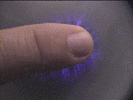THE ASSASSINS:Once again, the complexities of Islamic history will be dealt with very briefly. The Shi'ite branch of Islam had a number of schisms, the best-known being between the Seveners and the Twelvers, who believed that the seventh and twelfth imams respectively were the concealed and later-to-return Mahdi, or saviour-leader, who would restore Islamic purity. The Seveners, or Sabiyya, were Ismailis, named after the eighth-century Muhammad ibn Ismail, who died before becoming the seventh imam; a related Ismaili sect were the Nizari, named after the unsuccessful attempt to establish Nizar as the caliph or leader of the Ismailis on his father's death in AD 1094.
Hasan-i Sabbah was a Persian Twelver who converted to Ismailism and became an enthusiastic missionary for its cause, and a supporter of Nizar. In his youth he studied alongside the future tentmaker, astronomer and poet Omar Khayyam, and the future prime minister of Persia, Nizam ul-Mulk, whom he later had murdered. In 1090 he took control of Alamut (Eagle's Nest), a Sunni fortress high in the mountains of northern Persia, and established it as the centre of his operations. followers were named Assassins by the Christian Crusaders who encountered them. They were utterly dedicated to Hasan - sometimes known as the Old Man of the Mountains - and would kill or die on his order. There are stories, probably apocryphal, of Hasan demonstrating his power to honoured visitors by signalling to a follower standing guard on a high peak, who then cast himself to his death. mythic basis of this unquestioning loyalty is that Hasan had a beautiful garden in a hidden fertile valley in the mountains. The valley ran with streams of milk, honey, wine and pure water; its trees were heavy with fruit. Initiates were drugged, then taken to the valley, where for a few days they lived among its delights, which included palaces, musicians, singers, dancers and houris. Drugged again, they were returned to Hasan, and were told they had been given a glimpse of Paradise. If they swore an oath of absolute obedience to Hasan they would return there on their deaths. is some archaeological evidence of water cisterns carved in the rock at Alamut - and it is said that a narrow cleft in the rocks leads to a small fertile valley. The drug with which Hasan introduced his initiates to blissful happiness was cannabis; it was the Arabic word hashshashin (users of hashish) which the Crusaders adapted to Assassins - the word still used for high political murders 900 years later. (Some authorities say that the name was simply applied to the Ismailis as an insult by their more orthodox Muslim enemies, to suggest that they were addicted to vices; others claim the name comes instead from the Arabic Assasseen, meaning 'guardians'.) was a brilliant and ruthless ruler. He took advantage of the political chaos in Persia - he probably helped cause most of it - and he eliminated potential rivals. Within a very short time he had more real power than the supposed rulers, and was feared by Muslims and Christians alike. died in 1124, aged 90, having ruled through the fanatical devotion of his followers for nearly 35 years. His successors continued the tradition, having major political and religious figures killed, the killers being assured that if they died they would go straight to that Paradise of which they had already tasted. One very successful technique they used was to plant 'sleepers' in the Courts of rulers. They would not reveal themselves for years, even decades, until they received a signal, at which point they would kill the completely unsuspecting ruler. |
|
By the time of the fourth Grand Master, also called Hasan, his position as leader, or imam, was so strong that he could claim openly to be the Hidden Imam, the Mahdi, the direct mouthpiece of God. In the earlier years the Assassins had behaved outwardly as ordinary Muslims, but under Hasan II and his son Muhammad II they threw caution to the winds. The laws of Islam no longer applied; wine could be drunk, and pork eaten. This policy of open heresy was abandoned by their successors who, at least on the surface, adopted a form of Sunni Islam; the Alamut Assassins became relatively tame for a while. the Syrian branch of the Assassins became effectively an independent body, continuing to kill at will - or on commission. They were in regular contact with the Crusaders in Syria, and not always as antagonists. If it suited their purpose to fight on the side of the Crusaders to maintain their own position against their common Muslim enemies, they would do so. These were the Assassins who had most involvement with the Knights Templar, for a while paying the Templars 2,000 gold pieces a year to avoid direct military conflict with them.
The Assassins were eventually defeated by the Mongols in the middle of the thirteenth century. They were not wholly wiped out, however; in their two centuries of influence they had spread over much of the civilized world, including parts of India and southern Russia. Although no longer known as the Assassins, the Nizari (also called Khojas) still exist today as a small Ismaili sect, whose spiritual (and to some extent temporal) leader is the Aga Khan
Assassins are important to the current narrative for several reasons. They were a powerful, self-sustaining Order with several levels of initiation, oaths of obedience, and secret signs. Their beliefs varied from those of standard Islam, having something in common with Gnostic ideas. Among their beliefs were the teachings that heaven and hell were the same, and that no acts were sinful in themselves because the only good and evil were in obeying or disobeying the imam. Assassins are believed by some to have influenced the Knights Templar in a number of ways. Their uniform was a white tunic with a red sash, hat or boots: the colours of innocence, or purity, and blood. The Templars wore a white tunic with a red cross. The Assassins were organized, under their chief da'i or Grand Master, into senior da'is and ordinary da'is (missionaries); rafiqs (companions); fidais, fidavis or fedayeen (literally 'faithful', or devotees) who were the actual assassins, in the modern sense of the word; and lasiqs (laymen). The Templars, under their Grand Master, had grand priors, priors, knights, esquires and lay brothers. It is widely believed that the originally orthodox beliefs of this Christian warrior Order were affected by the beliefs of this most decidedly unorthodox Muslim Order.
To contents
 |




